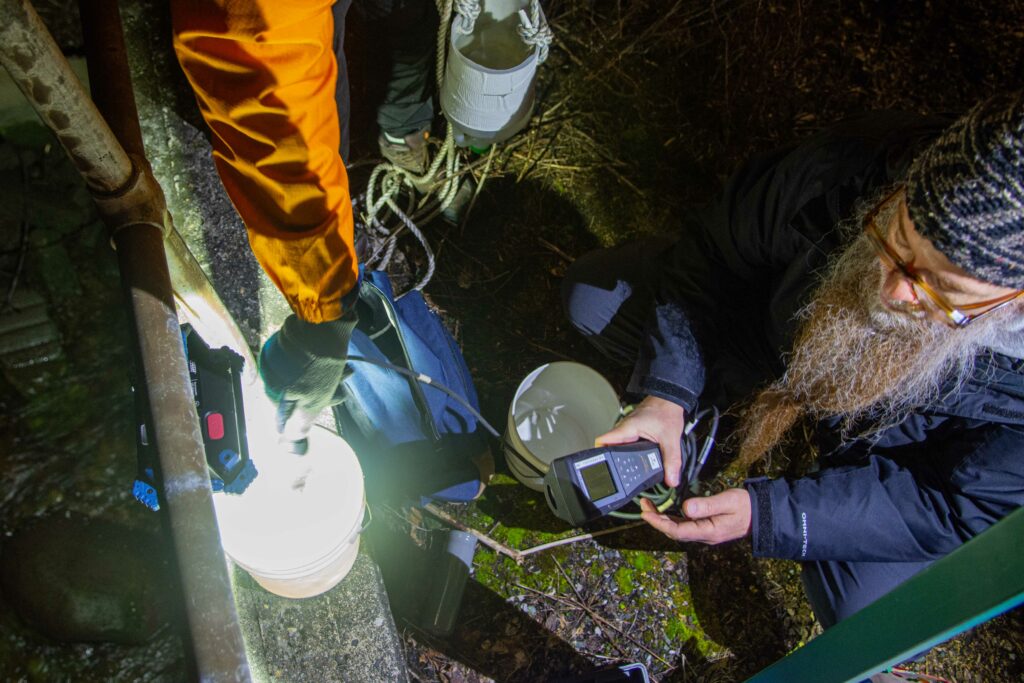By Riley Weeks, Communications Intern
It was a crisp, clear night. No rain. No wind. If it weren’t for the rows of street lamps on Harris Avenue, volunteers for the Salish Sea Stormwater Monitoring Program might have been able to see the stars. But instead they click on their own headlamps and lanterns, adding to the night’s glow.
They have a job to do.
Pat Burnett, Janie Egan, Steve Hansen and Ria Serrano, along with RE Sources’s pollution prevention specialist Kirsten McDade, gather at the mouth of Padden Creek, where its stream of freshwater water meets the salty smell of the sea. The team has to meet late at night to match the whims of the tide. Now, close to 7 p.m., the sea is finally out, and the team has access to the creek’s mouth without worry of salt contamination.
“I really like listening to what our world is telling us. I love the tide aspect of this job,” Burnett, who teaches engineering at Whatcom Community College, said.
Almost thirty different variables are collected from a bucket of water dropped down into the creek, from dissolved oxygen and water temperature to visuals like sheen and bubbles. Even the odor of the water is taken into consideration, since it can tell you something about the presence of pollutants. McDade sticks her nose into the bucket to get a good whiff.

A few smaller samples are also collected from the site that will be brought back to the RE Sources lab to test for bacteria like E.Coli and Enterococcus.
After finishing sampling at Padden Creek, the team moves on to the Bennett Street outfall, a pipe that funnels runoff from roads and yards, gurgles out into Bellingham Bay by Taylor Dock. Samples and data are once again collected, though this time the process is repeated twice to ensure accuracy. And there is an addition to the team here too: a small purple shore crab.
If you’ve read our previous post on Bellingham Bay, you know that we have a chronic pollution problem.
Bellingham, the city of subdued excitement, is also home to “the bay of subdued pollution” according to McDade. In some cases, areas are more subdued than others. Little Squalicum Beach for example, has some of the highest chronic bacteria levels in the entire state.
Middle-of-the-road pollution is also a huge challenge. Areas with high pollutant levels often face more pressure from regulators, whereas more subtle forms of pollutant areas stay under the radar. This often makes it harder to implement and enforce stricter regulations for clean and safe water, according to McDade.
Since RE Sources began a partnership with six other cities to create the Salish Sea Stormwater Monitoring Program, we’ve identified a whole host of pollutants, toxics, contaminants and other foul and smelly things in our waterways. And what we’ve found is in line with findings that toxic stormwater is the number one source of pollution in the Salish Sea.
It’s volunteers like Burnett, Egan, Hansen and Serrano that make this identification possible. They, along with a whole host of other volunteers, do this type of data collection monthly.
Back at the lab, the team begins another whole process. Burnett begins to boil water to sterilize the lab equipment while Egan works to write the sample information for each of the two sites on tiny gridded “R cards”. She also labels a card as the control that will just hold distilled water.




“If a petri dish was a tiny little piece of paper, basically,” Egan, a natural resource technician for the Skagit River System Cooperative said, explaining the R cards. “We’ll put it in the incubator and come back in 24 hours.”
Tiny little speckles will erupt on some of the cards, representing bacteria colonies. The team will count these colonies and report their data, including the variables measured onsite at Padden Creek and the Bennett Street outflow, back to McDade and Chris Wood, the stormwater program data manager, who will take the data and compile it with other volunteers’ data across the state.
Currently, McDade is working to ensure the data is queryable, which makes it more accessible for her and others interested in the data to run reports and draw scientific conclusions. She is also working on creating a three-year report of the data the Program volunteers have collected so far, which will be available on RE Sources’ website once completed.
It is this type of data that can convince policy makers and regulators to make a change. Just recently, thanks to the samples collected at the Bennett Street outflow, the Department of Ecology will begin monitoring the safety of the site for swimmers during peak swim season through their BEACH program.
This work was funded in part by a grant from Washington Sea Grant, University of Washington, pursuant to National Oceanic and Atmospheric Administration Award No. NA22OAR4170103. The views expressed herein are those of the author(s) and do not necessarily reflect the views of NOAA or any of its sub-agencies.
